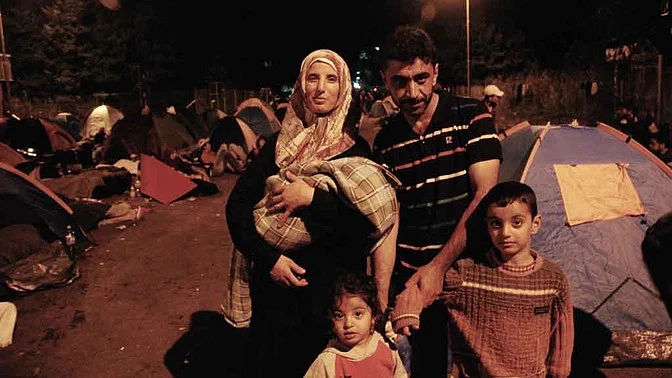On World Refugee Day, this is one from The Quint’s archives. Priyali Sur was reporting for The Quint on the ongoing refugee crisis that has threatened a “de-facto collapse of the Schengen system”. She sent us this report from a checkpoint along the Hungary-Serbia border.
It’s 1:30 am on one of the worst days of the refugee crisis on the Serbian-Hungarian border. Along with a group of volunteer aid workers, mostly Polish and Germans, we managed to cross the border to get to the Serbian side where thousands of refugees have been waiting to cross over to Hungary. Most are lying on the pavement under a ‘Duty Free’ board.
Others are opening up their tents right in front of the Hungarian cops, who are inches away across the fence, as though sending a message ‘we are not turning back’. Women and children try to stay covered under tents, but there aren’t enough tents for all of them.
As the night unfolds, Halim, a 26-year-old Iraqi refugee starts talking to me. He hasn’t told his family in Baghdad about his journey. He wants to get to Germany and pursue his Masters degree. Like others, he too has been on the road for weeks – from Iraq to Turkey (Turkey being the start point for all). He paid a dealer $2300 to get a jet ski and reach Greece.
A 75 km walk in Greece was the toughest, since the locals are not allowed to give you a ride in a cab or a car. That walk kills you. Even women and children have to go through it. Sometimes, people feel sorry for the women and children and give them a ride. Once you get to Athens, you find a dealer who takes you to the last Greek town, and from there you walk 5 km to the Macedonian border. At the border, for 50 Euros you can take a cab and they take you two hours across Macedonis to the Serbian border.
— Halim, Iraqi refugee
By the time most people get to the Hungary border, they are exhausted and have spent most of their money either on paying dealers to get across, or to authorities for paperwork. A closed border with police tear-gassing and water cannoning just makes things worse for them. The tear gas did come a day after Hungarian authorities sealed the Serbian border.
Next, Halim takes me to the other side of the tents. From a distance I can see a few bonfires, but the area is mostly silent. I ask him if there is anyone at all on the other side. He tells me he can’t explain and that it’s something I have to see to understand.
As I reach there, it’s a sight that can weaken the most strong-hearted. There are thousands of people wrapped in foils (insulation sheets) to stay warm, lying on the ground next to trash, looking like bags of garbage themselves.
A young Syrian mother tries to wrap her wailing baby in a stole and lowers him in what looks like a trash can that is covered with the same foil. A few men are sitting by the fire playing cards and strategising their next move – should they walk all the way to the Croatian border?
There are crutches lying next to sleeping people. Jamal, another refugee, tells me he broke his leg trying to jump a wall at the Turkish border. He was helped and given crutches by some volunteers.
The crowd of refugees at the Roszke-Horgos border is now thinning. The refugees have realised that an endless wait is not going to make the Hungarian government open the fence for them. Most of them are now moving in hordes towards Croatia.
Eleven thousand people have already reached Croatia, and with just one border crossing between Serbia and Croatia open now, others continue to cross through cornfields. Slovenia too has temporarily suspended rail routes from Croatia and has said it can offer shelter and care to only 5000 refugees.
Meanwhile, the Hungarian government is building another fence at the Hungary-Croatia border. Hungry, exhausted, and with very little money left, will these people make it to their final destination?
“We have come too far. We can’t go back. There is nothing left for us back there,” says Halim as he wraps himself in the foil and prepares for the long night and long journey ahead.
(At The Quint, we question everything. Play an active role in shaping our journalism by becoming a member today.)
